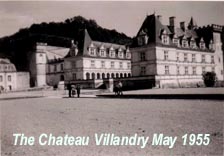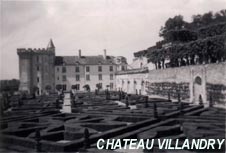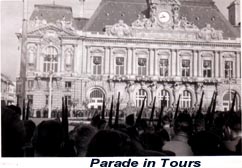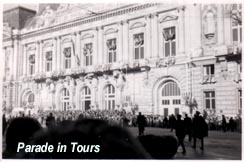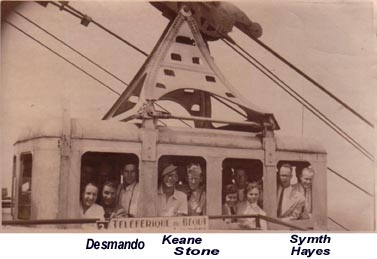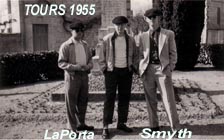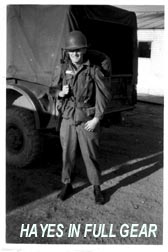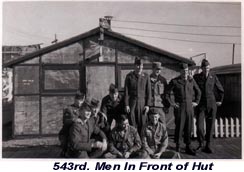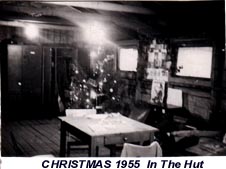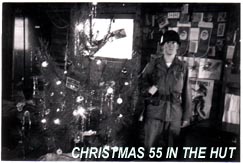January 2011 Update: Our thanks to those who served with the 543rd Engineering Company Pipeline who have posted their comments on the Chinon Hospital-Depot guest book. If you served with the 543rd Engineering Company Pipeline and would like to include your pictures on this web site, please email your pictures and stories to lrand@springcom.com.
Our special thanks to SP3 Marvin M. Smyth for sharing his memories and photos with us, We really appreciate them.
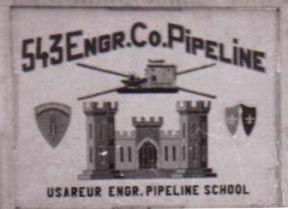
SP3 Marvin M. Smyth Has sent us some really nice photos. We will post them as space allows. Here is his story to open the 543rd's own page.
PERSONNEL & MISSION
I am not certain about the background and history of the 543rd. In Chinon, it was what was known as a "bastard" Company. By that, it meant it didn't fit the typical Army organization chart of being a part of a battalion, regiment, etc. Our Company Commander reported to the Chinon Depot commander.
I was told that the 543rd was an activated Alabama National Guard outfit called up during the Korean War. I am not sure when it came to Chinon or where it came from, but it had to be one of the early units that came into the Chinon Depot. I came to Chinon in 1955. The Army had established the Chinon Depot within 2 or 3 years prior to 1955
Why this unit was sent to Chinon is a puzzle to me. The only mission I knew that the 543rd was given was to run an eight week pipeline training school for other engineering units. During the year and one-half that I was with the 543rd, I only saw one training class come through. Also, during this same time period, the 543rd was given one field exercise in which they had to lay a designated amount of pipe, set up pump stations and get operational within a specified time period. One other exercise was some target shooting. The 543rd had about 50 carbine rifles. We (200 men) were trucked out to a French Army rifle range and spent a couple of days shooting at targets. We were shooting from two distances, one at about 50 yards and then back at 100 yards. The old Army field telephones were set up at the side of the range from where we were shooting and going back to the target area, so they could communicate with one another. When we moved back from the 50 yard location to the 100 yard location, someone forgot to move the telephones. It didn't take long for the troops to notice the telephones and they ended up with more bullet holes in them then the targets. This was the first (and last) time most of the men shot a rifle since basic training and for many the first time they fired the carbine rifle. I think for most days, the men's duty assignments were small keep busy jobs in the Company area and/or they were used a laborers for various Depot projects. Some had permanent assignments up at the Depot in clerical jobs, SP's and similar jobs.
When I arrived at the 543rd in March 1955, Captain Robert J. Collins was the Company Commander. Capt. Collins was an excellent leader and well respected by the troops. Our First Sergeant was SFC McGee. Sgt. McGee was from the Louisiana bayou and claimed he spoke better French then the French did. I can't remember the time frame, but I think in early 1956 the 543rd was taken over by 1st Lt. Odell Nails who had been our Executive Office. (I ran into Nails after I got out of the Army at my local college campus where we were both attending. He later became Superintendent of Schools in the City of Pontiac,Michigan.) In the late Spring or early Summer 1956, when we moved up to the hospital area, we again got a new company commander, Captain Kemp. At the same time we got a new first sergeant, SFC Remo Witt. Both were new arrivals from the States.
Sgt. Witt was probably the most interesting characters I met in the 'Army. Sgt. Witt was one of those "old" Army men. He had his first name "R-E-M-O" tattooed on the knuckles of his left hand and his last name "W-I-T-T" tattooed on the knuckles of his right hand. I believe he said he joined the Army in 1939. During WW II in 1942 or 1943 when the U.S. went into North Africa to help the British fight the Germans, Witt was a Master Sergeant in charge of maintenance and repair of Army tanks. One day, while off duty, he was in a bar and had a little too much to drink and punched out a U.S. Army officer. As a result of this altercation, he was reduced one rank, to a Sergeant First Class and transferred to the Infantry.
Sgt. Witt spent the balance of the war as an NCO in an infantry company fighting in various battles all the way to Germany until the war ended. During one of our discussions on military medals, I asked about how he got his Silver Star. He said it was not a particularly heroic incident. His unit was entering a German town. He was laying behind a log in the road. The Germans were trying to get behind him and his men. They had to cross this road in order to accomplish that goal. As they ran across the road, he shot them. Then another would come out to either cross the road or help his comrade and he'd shoot him. When it was all over, he had shot 13 German soldiers and was awarded the Silver Star. He said another incident that was really nerve racking took place in another German town. He was engaged in street fighting in this town. As he turned a corner, there he was nearly nose to nose to a German soldier from the elite SS unit. The German lowered his rifle to shoot point blank at Sgt. Witt and it just clicked, no ammo. Sgt. Witt, almost simultaneously, aimed and pulled his trigger. The same thing happened to him, no ammo. They both had fixed bayonets and proceeded to fight it out with their bayonets. As Sgt. Witt remarked, "I don't have to tell you who won!" He said when it was finished his knees were feeling awfully weak. He said the incident was more deserving of a Silver Star, but of course that didn't happen.
Sgt. Witt continued his quest to get his Master Sergeant rank back. It did not happen during WW II and up to the time he was sent to Chinon. Prior to Chinon he was stationed at Fort Bragg, NC where he was first on the promotion list. Shortly after he left for Chinon, the number two man on the list got the MSgt. promotion. After I left the Army in September 1956, I heard the SFC Witt finally got his Master Sergeant rank. I'd say it was well over due and he deserved it.
SP3 Marvin M. Smyth US55500137
-------------------------------------------------
543rd Engineering Company (Pipeline)
MY EXPERIENCES
I started my Army basic training in mid-October 1954 at Fort Leonard Wood, MO, finishing at Christmas. I then got orders for Clerk-Typist School at Fort Leonard Wood and finished that training (Clerk MOS) in February 1955. I then was shipped to the east coast and put on a troop ship for a 13-day voyage across the winter Atlantic Ocean to Bremerhaven, Germany. In Brernerhaven, I got orders for Chinon, France. I had no idea we had troops in France. Asking around to permanent staff, I got the word that it was "bad" duty. They put us on a train and we were on our own to find Chinon. I was accompanied by an Army friend, Mike Stone, we had been given the same assignments for basic training, clerk school and again, we were both assigned to the 543rd in Chinon, France, though we had not known each other prior to Fort Leonard Wood.
We found our way to Tours, France and there some other GIs told us where to catch an Army bus to Chinon. It was a cold, rainy, cloudy day. The bus driver stopped on the road between Tours and Chinon and pointed to his left and said "welcome to your new home" and laughed. We went into a building that was a Battalion headquarters for an outfit (I cannot remember it's name). In there we were told to go down the road a short distance and that was the 543rd, As we walked through the mud, I noticed all these tar paper shacks. We entered this small building that was the Headquarters for the 543rd. In there we were taken to one of the shacks which had bunks stacked two high, with a pot belly stove at each end of the shack. (We were the new guys, so we got a double bunk in the middle of the shack away from the stoves) The windows were on
hinges and instead of glass were covered with plastic sheets. The walls were not finished, the 2 x 4 studs had half inch boards on the outside covered with the tar paper. .1 asked if the 543rd was out on field maneuvers and where were the permanent barracks located. Again, I got a laugh and was told that was our "permanent barracks".
Other unexpected luxuries were the king sized out house (no plumbing); outside urinals made from roof gutters; a showers/washing shack that had water trucked in, heated (sometimes) to one temperature and used until it ran out. Drinking water was located in a tank trailer outside the mess hall which matched the outside temperature. It was a good idea not to look at the water while drinking it because there were various things floating in the water. Electricity (when available) was from a gas generator. Coal burning pot belly stoves usually burned out by morning. The snack bar was several miles away on the depot post. Another mile or so from the snack bar was a warehouse used as a movie theater. . The recreational facilities for the 543rd consisted of one pool table for 200 men. Obviously, there was no television. You could have a radio if you bought your own. Last, but not least was the mess hall and the food. I really found out why the term "mess" was used by the Army. We were given the typical Army food tray and a mess gear drinking cup, which we kept in our shack. We went through the food line, sat at picnic type tables and ate. After eating we'd go outside, dump any scraps in a garbage can, wash our tray and cup in another garbage can with heated (sometimes) soapy water and rinse in another garbage can. The trick here was to eat early and wash your gear early otherwise the wash and rinse cans were disgusting. Rumor was that a lot of our fresh food was being sold on the French black market. I never did believe that story, but it did seem strange that we ate C ration type food frequently. Also, if you didn't get your food tray good and clean, you did spend time sitting in the out house with the runs.
I soon found out that besides Mike Stone and I, the 543rd had been assigned another dozen or more men with the Clerk MOS and only one clerk job existed, the Company Clerk, and he had many months to go before he would be heading home. So, they decided to put Mike and I on a "field" assignment. Our job consisted of going out in the depot field where 10 foot, 180 pound pipe had. been dumped and straps holding, bundles together had, broken and the pipes were_laying_ loose in the field. Our job was to manually pick up the pipe, load it on a flat bed truck then it was transported to a closed in shelter and stored. As you can imagine, by the end of the day, the 180 pound pipe was feeling like 380 pounds. The worse part of the job was that it was boring. I had 18 months to go and needed to find something better to do.
One of my new friends was our Mail Clerk, George Hayes. George was doing yard work out at one of the officers homes and said if I wanted, I could help him. I grabbed on to that job. 1 enjoyed the work and mostly the good civilian lunch we would get every day. One day George told me that there was an opportunity for some men to get 8 weeks training in Construction Surveying at the Army Engineering School in Murnau, Germany. I talked my old friend Mike into joining me in applying for this school. We were accepted and we were on our way to Murnau by late June. It turned out to be an excellent experience. Good food, great living conditions and a shower everyday, toilets that flushed, etc. The program was very interesting and in a field I had never previously experienced. We had good instructors and though we had to "soldier" a little, it was worth it. We also enjoyed visiting the most beautiful part of Germany, Bavaria including Garmish.
After finishing the training, we returned to the 543rd. I never used the surveyor training and for several months did miscellaneous jobs. Finally, the company clerk left for home and I got his job. I stayed on that job until I rotated home in late August 1956. I did enjoy the company clerk job.
The 543rd moved into the new hospital in, I believe, early summer 1956. Much improved living conditions, better food, running water, showers, flushing toilets, etc. One other important event for me was to finally get some dental work done by the new dentists in a new dental clinic. The one dentist we had up to that time was a disaster. I was only there a few months when I left for home and I understand living conditions and recreational facilities got even better.
SP3 Marvin M. Smyth, US55500137
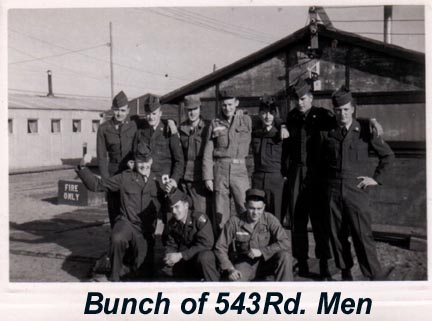
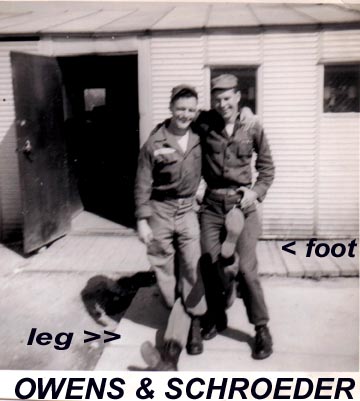
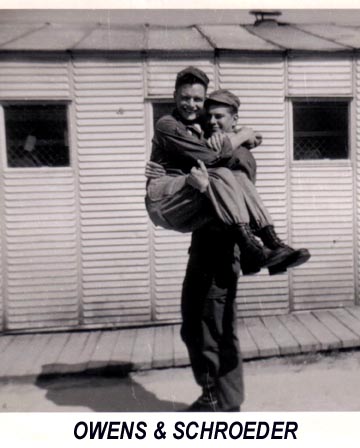
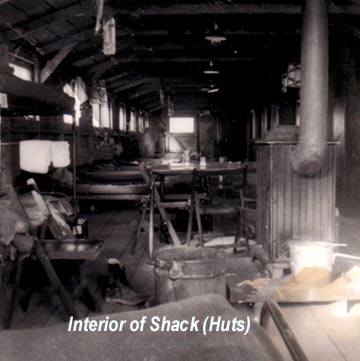
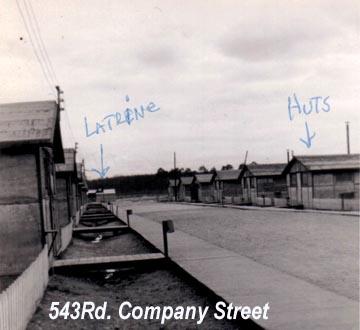
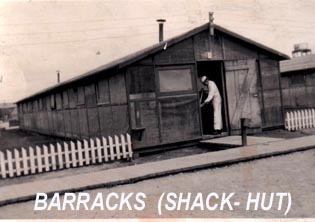
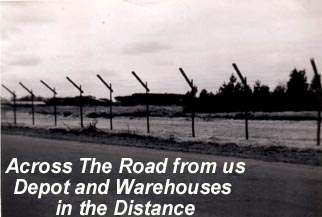
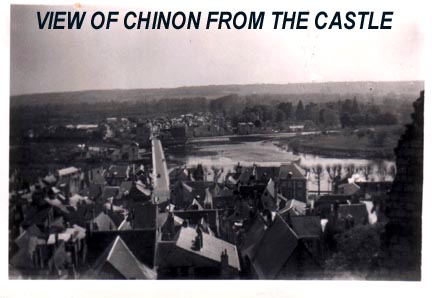
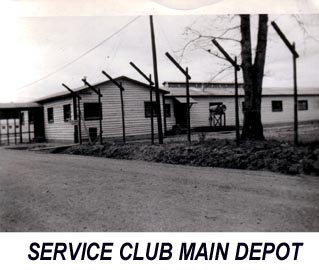
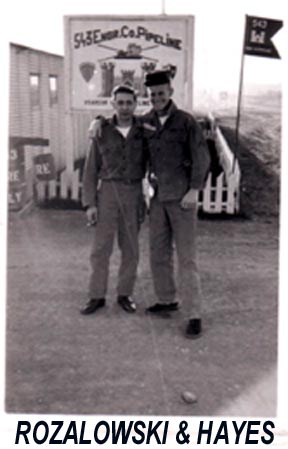
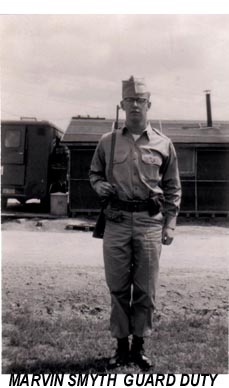
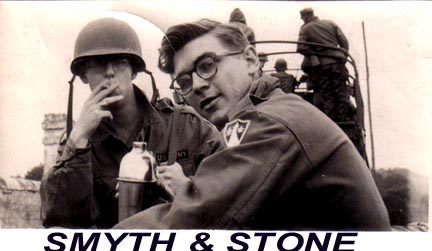
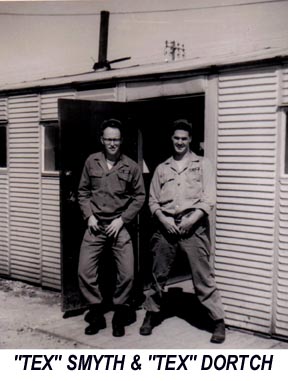
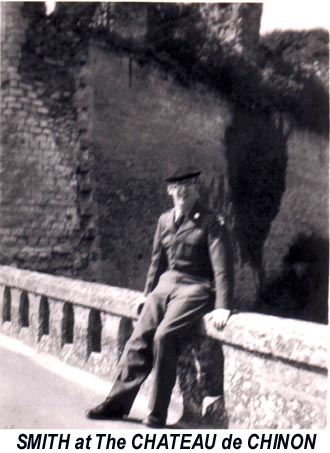
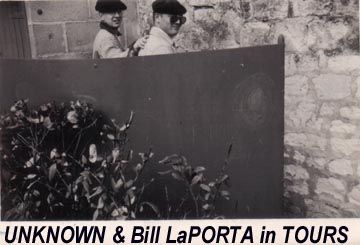
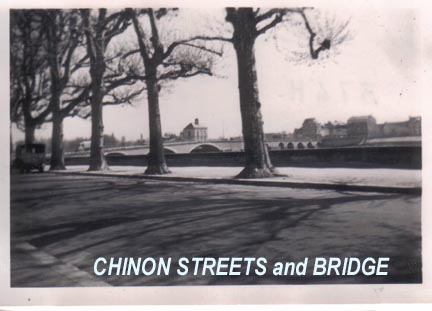
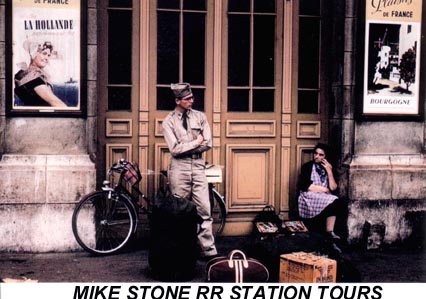
FOLLOWING 8 weeks of construction-surveyor training, in Murnau, Germany, My Army buddy Mike Slone and 1 made our way back to our unit, the 543rd Engineering Company, in Chinon, France. The school in Murnau was fairly demanding, but the living conditions and the food more than made up for it.
By contrast, in Chinon, we were housed in tar-paper shacks with no running water, no electricity (we had generators) and no indoor toilet facilities. Heat came from coal-burning, potbellied stoves. The food was terrible, even by Army standards.
Mike is pictured (above) in the 1955 photograph as he and I waited in Tours, France for transportation back to our tar-paper shacks. The expression on Mike's face says it all as to how we both felt about returning to Chinon. —Marvin Smylh, Dearborn, Michigan
This photo appeared in the October-November 2007 Issue of Reminisce magazine
